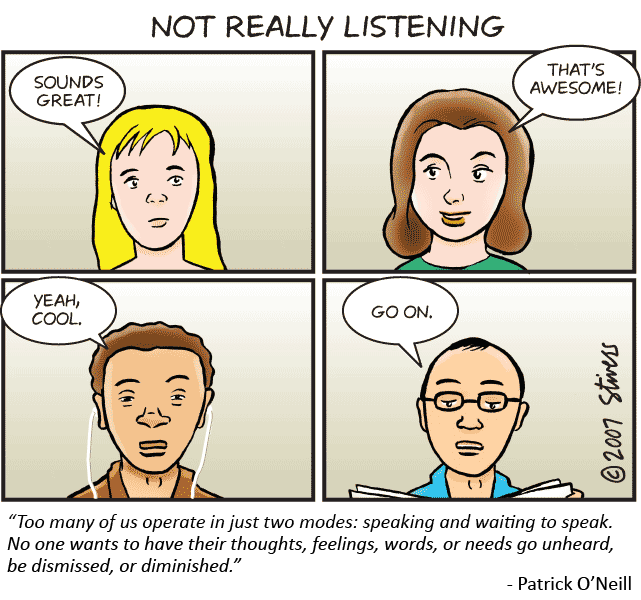Listening is the most underutilized and essential element there is for meaningful conversation. It is good for whatever ails any meeting. Although it does not cure a common cold, it does prevent misunderstandings, strengthen relationships, and help people clarify their thinking. So, why don’t we listen more deeply and more often? Among many possible reasons, three stand out: tit for tat behavior, fear, and lack of skill.
“Tit for tat” or “you aren’t listening to me so I won’t listen to you” is the modus operandi in many meetings. Although some will occasionally throw in a “That’s great” or “I hear what you are saying” they never actually let you know what in fact they are hearing. They say things like this either because someone in a communication skills class told them to or they use it to segue to what they want to say.
Four fears can get in the way of listening. First, we are more afraid that we won’t get a chance to talk than we are that we won’t understand someone else. Second, we are afraid to listen because what we hear might challenge our beliefs, opinions, or positions. Third, listening can be scary because it is intimate; it moves us closer. Thus, listening takes a certain amount of courage: a willingness to listen to understand first, to be open to changing, and to be willing to be vulnerable.
Finally, we might also be afraid that talkers won’t stop. As an introvert who is a good listener, I understand this fear well. Sometimes I think I was born with a sign on my forehead that reads “Designated Listener.” People, especially extraverts, can often go on and on until they feel heard or they understand what they are trying to say. They think out loud and often don’t know what they think until they hear themselves say it.
Skills and clear intentions are key to listening in ways that move a meeting forward constructively.
Listening involves (1) being quiet and stilling your mind so you can receive what others are saying; (2) encouraging people to talk by head nodding, making eye contact, or vocalizing “hmm”; (3) testing whether your comprehension is accurate by saying what you think others have said or are feeling (“Let me see if I have this right. You are saying that…”); and (4) deepening your understanding by asking open-ended questions or simply saying, “Please tell me more about that.”
When you are afraid people will never stop talking, you can help them clarify their thoughts and feel heard by feeding back key points to them. “I need to stop you for a moment and make sure I understand what you have said thus far. Here are the points I heard you make…Is this right?” This is not a panacea but usually helps them get to the essence of what they are trying to say.
When I teach listening skills I get surprised by the number of people who think that giving advice, describing one’s own experience, or agreeing with someone is listening. Although there are times when these actions are useful and appropriate, they are not listening. Listening means really trying to understand what others are saying, seeing the world through their eyes. It is about those who are speaking. Giving advice, describing how you relate to what someone has said, or agreeing is about you. It is how you see things.
To get others to see the world through your eyes, you need to see it through theirs first.
Probably the most important part of listening is your intention: you really “gotta wanna.” You can use any of the skills but without a true desire to understand what others are saying they ring hollow and can evoke defensiveness. Even if you are not adept with the skills, your intention to listen and understand will be apparent.
When people sense they are being listened to and heard their thinking clarifies and deepens. They experience a sense of belonging that helps them be a part of something greater than themselves. This encourages them to bring the best of who they are to the conversational table.


Excellent advice from one who loves to talk……..after I listen.